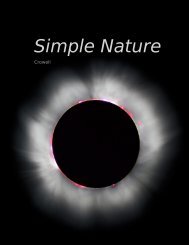The size of a radio antenna is closely related to ... - Light and Matter
The size of a radio antenna is closely related to ... - Light and Matter
The size of a radio antenna is closely related to ... - Light and Matter
Create successful ePaper yourself
Turn your PDF publications into a flip-book with our unique Google optimized e-Paper software.
Problem 16.<br />
16 A Fabry-Perot interferometer, shown in the figure being used<br />
<strong>to</strong> measure the diameter <strong>of</strong> a thin filament, cons<strong>is</strong>ts <strong>of</strong> two glass<br />
plates with an air gap between them. As the <strong>to</strong>p plate <strong>is</strong> moved<br />
up or down with a screw, the light passing through the plates goes<br />
through a cycle <strong>of</strong> constructive <strong>and</strong> destructive interference, which <strong>is</strong><br />
mainly due <strong>to</strong> interference between rays that pass straight through<br />
<strong>and</strong> those that are reflected twice back in<strong>to</strong> the air gap. (Although<br />
the dimensions in th<strong>is</strong> drawing are d<strong>is</strong><strong>to</strong>rted for legibility, the glass<br />
plates would really be much thicker than the length <strong>of</strong> the wavetrains<br />
<strong>of</strong> light, so no interference effects would be observed due <strong>to</strong><br />
reflections within the glass.)<br />
(a) If the <strong>to</strong>p plate <strong>is</strong> cranked down so that the thickness, d, <strong>of</strong><br />
the air gap <strong>is</strong> much less than the wavelength λ <strong>of</strong> the light, i.e., in<br />
the limit d → 0, what <strong>is</strong> the phase relationship between the two<br />
rays? (Recall that the phase can be inverted by a reflection.) Is the<br />
interference constructive, or destructive?<br />
(b) If d <strong>is</strong> now slowly increased, what <strong>is</strong> the first value <strong>of</strong> d for which<br />
the interference <strong>is</strong> the same as at d → 0? Express your answer in<br />
terms <strong>of</strong> λ.<br />
(c) Suppose the apparatus <strong>is</strong> first set up as shown in the figure. <strong>The</strong><br />
filament <strong>is</strong> then removed, <strong>and</strong> n cycles <strong>of</strong> brightening <strong>and</strong> dimming<br />
are counted while the <strong>to</strong>p plate <strong>is</strong> brought down <strong>to</strong> d = 0. What <strong>is</strong><br />
the thickness <strong>of</strong> the filament, in terms <strong>of</strong> n <strong>and</strong> λ?<br />
Based on a problem by D.J. Raymond.<br />
17 (a) A wave pulse moves in<strong>to</strong> a new medium, where its velocity<br />
<strong>is</strong> greater by a fac<strong>to</strong>r α. Find an expression for the fraction,<br />
f, <strong>of</strong> the wave energy that <strong>is</strong> transmitted, in terms <strong>of</strong> α. Note that,<br />
as d<strong>is</strong>cussed in the text, you cannot simply find f by squaring the<br />
amplitude <strong>of</strong> the transmitted wave. ⊲ Answer, p. 930<br />
(b) Suppose we w<strong>is</strong>h <strong>to</strong> transmit a pulse from one medium <strong>to</strong> another,<br />
maximizing the fraction <strong>of</strong> the wave energy transmitted. To<br />
do so, we s<strong>and</strong>wich another layer in between them, so that the wave<br />
moves from the initial medium, where its velocity <strong>is</strong> v 1 , through the<br />
intermediate layer, where it <strong>is</strong> v 2 , <strong>and</strong> on in<strong>to</strong> the final layer, where<br />
it becomes v 3 . What <strong>is</strong> the optimal value <strong>of</strong> v 2 ? (Assume that the<br />
middle layer <strong>is</strong> thicker than the length <strong>of</strong> the pulse, so there are no<br />
interference effects. Also, although there will be later echoes that<br />
are transmitted after multiple reflections back <strong>and</strong> forth across the<br />
middle layer, you are only <strong>to</strong> optimize the strength <strong>of</strong> the transmitted<br />
pulse that <strong>is</strong> first <strong>to</strong> emerge. In other words, it’s simply a matter<br />
<strong>of</strong> applying your answer from part a twice <strong>to</strong> find the amount that<br />
finally gets through.) ⊲ Answer, p. 930<br />
Key <strong>to</strong> symbols:<br />
easy typical challenging difficult very difficult<br />
√<br />
An answer check <strong>is</strong> available at www.light<strong>and</strong>matter.com.<br />
380 Chapter 6 Waves














